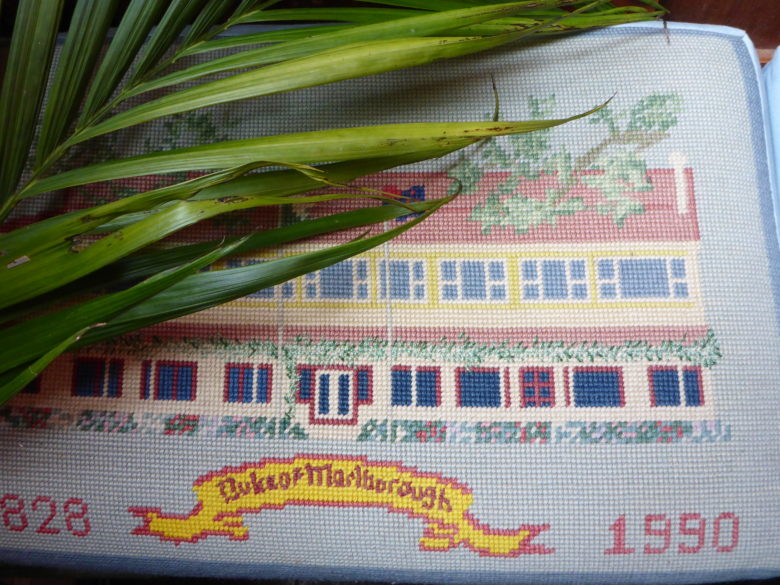Nature’s Palette in the Pukenui Forest
There are two loops of forest track in this remnant of native woodland just behind Whangarei. One meanders at low level alongside a little river for 8.2km while the other branches off it and climbs, steeply in places, to ‘the rim’, follows the rim right around and back to the start over 8.9km of terrain more suited to a mountain goat than two bi-legged geriatrics.
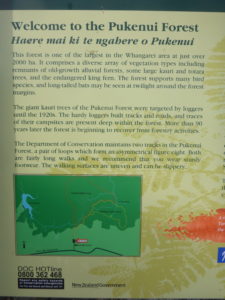
We decided on the former and ended up, through a miss turn, on the latter. Well clinging on to roots for dear life and eyeing up curious hollows at nose level didn’t seem to be following a meandering low level route.
Our route was thankfully marked with little orange plastic triangles which worked fine except for the one that was attached to a fallen palm and showed a route that took horizontal flight to the left. The magical trail itself was often no more than a worn animal path over a root-bed and disappearing into the undergrowth ahead.
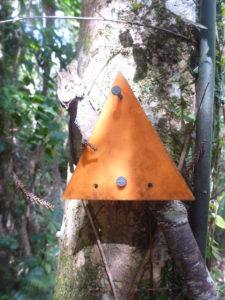
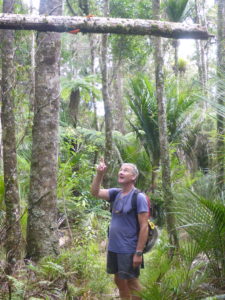
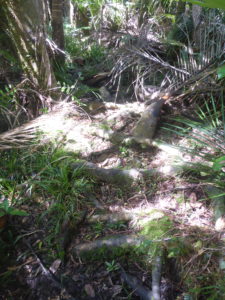
This gem of a forgotten place, home to kiwi and ‘protected’ by the Department of Conservation (DOC) was full with natural design and vibrant colour. In the death and decay of fallen trees a kaleidoscope of colours and shapes thrived. Two toned fungus and shiny green ferns and moss were shown off to their best by the sun.
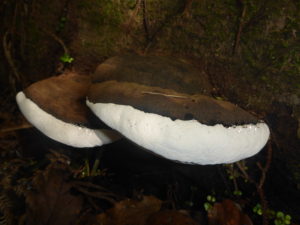
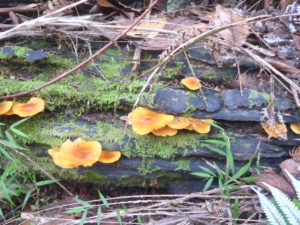

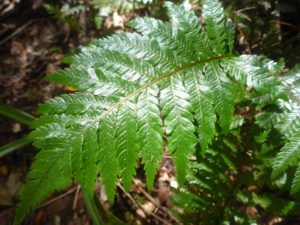
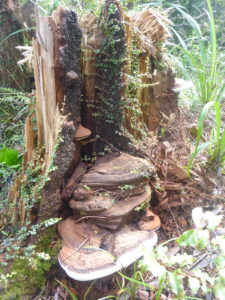
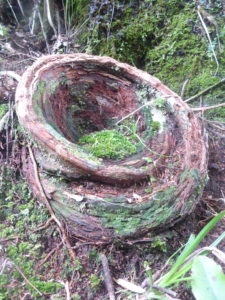
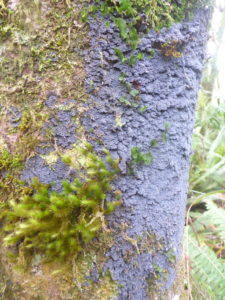

We were able to drive there because Jeannie and Merv had generously loaned us their little 1995 Suzuki Alto Hatchback. Jeannie’s mother, Alaine, had passed away and so Jeannie had use of her late mum’s car meaning Tui, as I promptly nicknamed her, became free for our use until we left for Fiji.
A few kauri were overlooked by the loggers who left the Pukenui Forest in the 1920’s and it has taken this long for the forest to start recovering in the decimated areas around them. One kauri had forked just above ground level, see Rob posing infront of it and further along was a sign to ‘The Kauri’. The special little path was blocked by one of the massive spear leafed plants that normally lives in a cleft of tree branches and had fallen from its lofty home; you would not want to be standing beneath when it fell. But peeping around it we saw the kauri in question, a cousin of the kauris on the west coast.
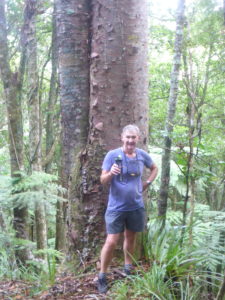
In the photo I am illustrating the early stages of using the boat shaped base of a fallen palm leaf as a sledge. Merv told us how as a boy he and his mates would open up the leaf base, sit on it and slide purposefully down the nearest available slope. A master of innovation is our Merv.
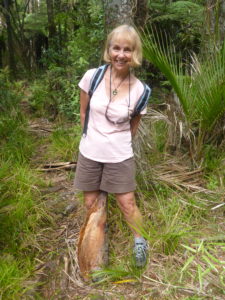
While back in the UK I had used Buffalo Glue to repair my new last February walking shoe as the upper was separating from the sole around the toe. The glue had dried hard and as the toe flexed while I walked it was again pulling away from the sole. A few emails between Zoonie and the shop manager in Dunedin where I bought them and I now have a brand new pair, plus a spare pair of inner soles and laces. I thought I might grow herbs in the old ones but Rob snuck them up to the bin before I could reach for my trowel.
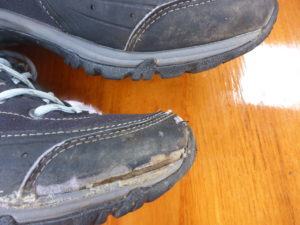
Kororareka (Sweet Penguin) latterly known as Russell ‘Hell Hole of the Pacific’.
A Maori legend tells of a chief, felled in battle, asking for some flesh of the sweet penguin to speed his healing progress, hence the first name of this small town on the sheltered main shoreline in The Bay of (144) Islands on the north east coast of the North Island.
Chief Tamati Waka Nene saw all the painful birth pangs of early pakeha life since the area was his home throughout his life from 1780 to 1871. He welcomed the early whaling ships, the first settlers, the Wesleyan missionaries, the French Catholic contingent and the British government representatives seeking to claim this New land for the far away young and beautiful Queen Victoria.
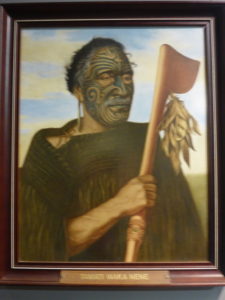
He helped to teach Johnny Johnson, an intelligent ex-convict, the Maori language and thus forged a friendship that lasted for life. In 1827 Johnny bought an alehouse on the shorefront and called it Johnny Johnson’s Grog Shop. Sometimes the excellent deepwater anchorage off the shore infront of the pub was temporary home of up to fifty whaling ships that had been at sea for upwards of a year. Well you can imagine the pent up emotions of the young male crew can’t you. Johnny did too and fed, watered and womaned the sailors as much as their hearts could want, or rather their pockets could afford.
The result was inevitable and earned this place the second name in the title for a little over ten years. The disreputable reputation spread far and wide, attracting more debauchery and prostitution until, young and ambitious Captain William Hobson (who gave his name to Mt Hobson on Great Barrier Island, remember me wondering where it got its name) arrived as Lieutenant Governor in 1840 and with undue haste arranged the writing of the Treaty of Waitangi, just over the water from Russell at Waitangi, which theoretically but not in practice ‘preserved’ the rights of the Maori while commandeering land ownership for the settlers and British Government.
Johnny of the Grog Shop helped translate the treaty into Maori and was uncomfortable that both versions meant quite different things. He was right, the Treaty is still a bone of contention between the Maoris and NZ government.
Johnny’s good friend Chief Tamati Waka Nene supported the Treaty and fought with the British troops and Colonial Forces against Hone Heke who maybe had more vision because he could see how Maori power and entitlement was under threat. He expressed his fears for their future by felling the Flagstaff on the hill beside Russell three times after the capital was established. They were defeated, so then Tamaki acted as mediator for them, he sounds like a born peacemaker and diplomat and was recognised as such at the time becoming Maori adviser to the new government.

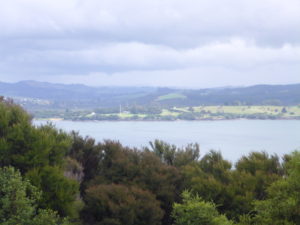

By this time Johnny was thinking he should roll on the respectable for his alehouse so he chose to name it after the wealthiest man in the world at the time, The Duke of Marlborough and Russell started its uneasy transition to respectability while the politics moved on rapidly southwards.
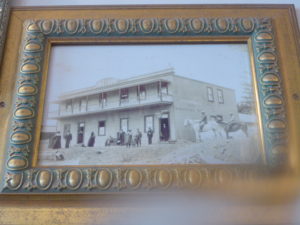
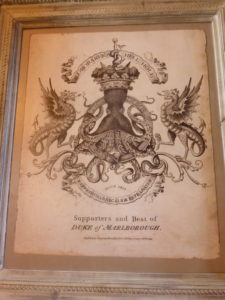
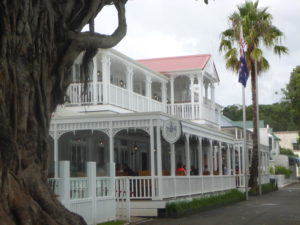
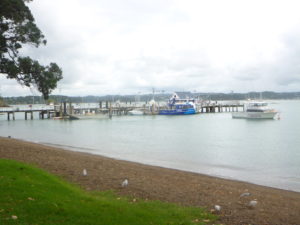
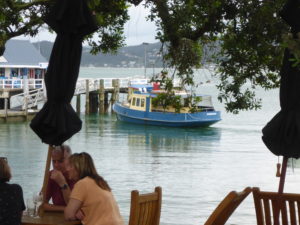
Remember when we visited James and Jane Clendon’s home at Rawene when we were touring the north-west coast and the Hokianga Harbour? Well James had arrived in Russell in 1832 and set up a trading station servicing shipping. He was a public spirited man and took on the role of JP and Magistrate, he must have had his work cut out in those rough and ready days. He was promoted to US Consul in NZ under Captain Hobson, who with the Treaty signed by at least a few of the Maori chiefs, established the first government.
Hobson needed a base for the government and commandeered James’ home where he lived with his first wife Sarah and their children on a promontory overlooking the water in Okiato.
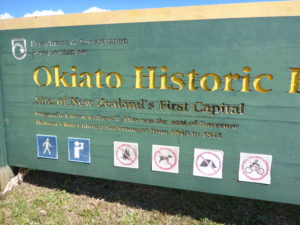
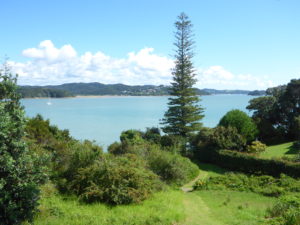

In exchange James was given a raw deal, a small sum of money and a useless section mostly of mangrove swamp near Auckland. With all that fine land around I wondered why Hobson was being so mean, maybe they had a falling out.
Within months of James and his family being booted out of their home the seat of government was moved to Auckland and quite why James didn’t take back his home I am not sure, the ink of the sale could barely have dried on the paper, but on May day in 1842 his beautiful home was burned to the ground and that was that.
It could have been a victim of the battle that took place against Hone Heke after the signing. James needed a home so he built a pretty little cottage next to the Pompallier Catholic Mission on the shorefront just down from the Marlborough in Russell before leaving the area entirely and starting afresh in Rawene. It is now the coffee and culture café and shop through which we passed to visit the Mission and later enjoy a coffee and pastry overlooking the water.
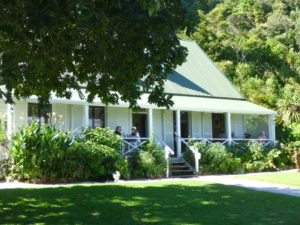

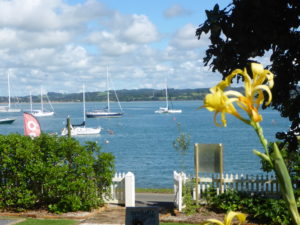
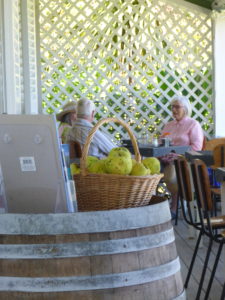
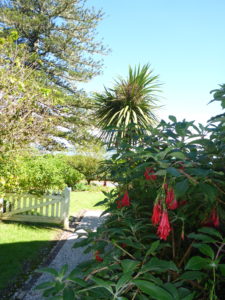
Charles Darwin visited the town in its wild time and felt the residents were in need of some ecclesiastical and spiritual support so he donated a generous sum to the building of Christ Church, NZ’s oldest church. James first wife Sarah Clendon and two of her grownup children are buried in there along with Tamati Waka Nene and three generations of ‘Ford’ family members, I wonder if they are from Rob’s Mom’s ancestral line. One day we will trace our family trees thoroughly and find out.
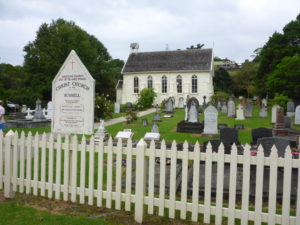
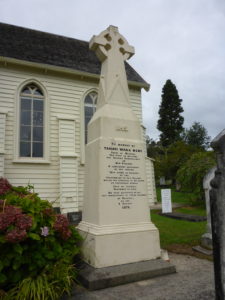
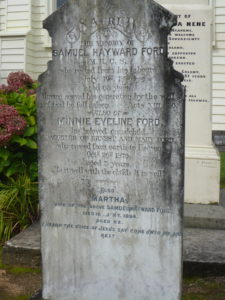
The friendly fusion between the resident Maoris and the incoming foreigners is evident in numerous ways and recorded on the beautiful hassocks in the church where the congregation showed multi-coloured faces raised in faith to the preacher from the day of its consecration. I will let the photos tell the story.
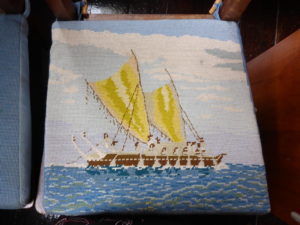
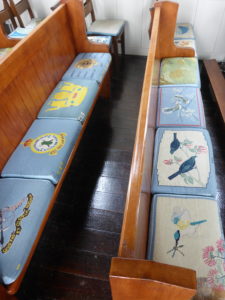
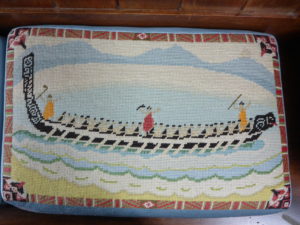
Another building where French Catholic churchmen worked hard to satiate the Maoris thirst for the new faith was in the Pompallier Mission, a printing press factory where Marist monks from Lyon worked tirelessly producing bibles in the Maori language for free distribution far and wide. These intelligent Maori tribespeople quickly learned to read their own language and I would have loved to have been around to witness this revolution in their culture and help in the teaching process.
A sweet irony was that the printers of Pompallier needed the copious amounts of urine from the alehouses for the tanning process, to soften the leather used for the book covers. Lydia showed us around and as we had arrived between the routine tour times we had her wealth of knowledge and humour to ourselves.
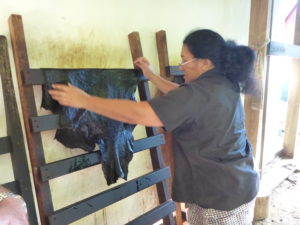
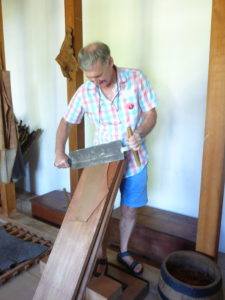
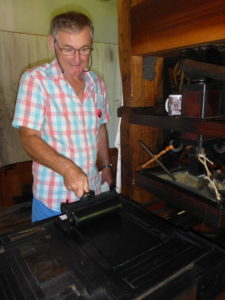
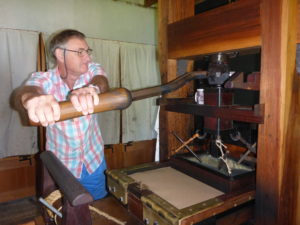
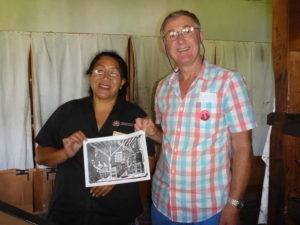
Mummified rats found around the walls and under the floors of the building when it was restored to its original purpose a few years ago attested to the affluence of the two families who owned the building and converted it into a house for a number of years between 1879 and 1943. One rat was found nestled amidst chewed scraps of the Financial Times, an entrepreneurat, and another was found under the kitchen floor still wearing a thick layer of body fat, a fat rat, either way the missions only permanent residents as they now rest behind glass in the museum on the top floor.
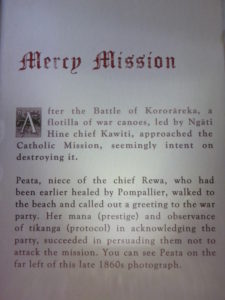

Johnny’s fortunes were going from good to great. After the signing he obtained the first liquor licence in NZ, which is framed and hangs on the bar wall, and after over a decade of ‘colourful’ business the hotel was finally legal.
It took a few years for Russell to fully settle down because moving the capital away caused a local decline in business and in the resulting battle of Kororareka (Russell) in 1845 the hotel burned down. Johnny quickly rebuilt it but both the new one and the next also succumbed to flames. Today’s grand building was once the accommodation block for the Cable Station at Doubtless Bay (that exquisite bay where we camped with the family last April). How well do New Zealanders move buildings. This one was barged into place in 1932.
We checked into our motel room for the night and walked in to the town for the evening. Sitting under the starting room above the information kiosk at the end of the pier we were on the start line for the traditional Wednesday evening handicap sailing race with 8 entrants of all shapes and sizes including a Dragon class (elegant lines and swift in the right hands) and a Flying Fifteen (stable and as it was once the smallest keel boat and possibly still is, it should be uncapsizable; Rob’s parents used to sail one ((Coffee and Cream)) on Rutland Water).
Fingers in our ears for the guns, it was familiar fun to watch the jostling for best start positions. One ambitious helmsman ordered the raising of the spinnaker for the down-wind start, a gust teased him into a broach so from our vantage point it seemed he must ram a big moored motor boat. In sorting himself out he crossed the line last.
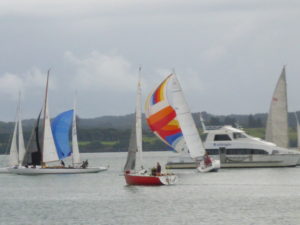
While this was going on the R Tucker Thompson Brigantine arrived after a day exploring the islands with her fortunate crew. The punters dropped off at the quay the young lad and lady crew, one to the bowsprit and the lass up the mast, to stow the sails while the skipper reversed out and took his vessel to her overnight mooring.
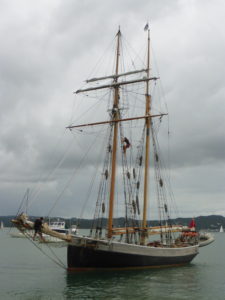
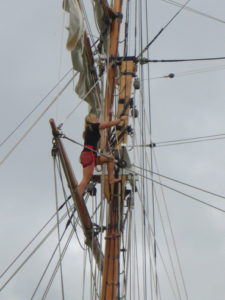
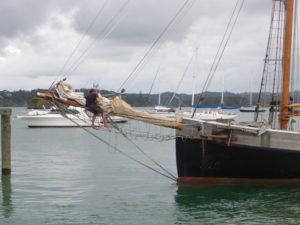
While lying in bed at our nocturnal mooring we listened to the cries of a morepork couple and the kiwi lookalike, a weka.
The drive back the next day down the Russell coast road was pure magic. We stopped a couple of times just to enjoy a stationary view of the surroundings. I’ll let the photos speak for themselves.
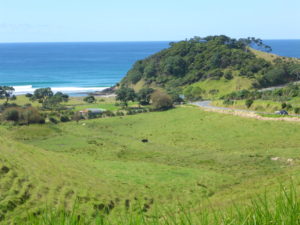
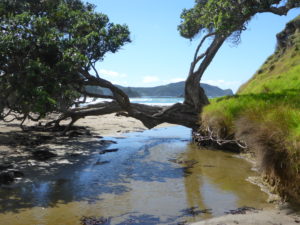

Wanderings around Whangarei
It really has become our home, this warm part of Northland, warm people and a warm climate. A non-permanent home but a home all the same.
The auto pilot is now fixed. It had a seal that didn’t, so the inside was not only wet but there was a build-up of carbon on its working parts. To dry it the ram was placed in a bake oven and to ensure the bottom of the lazarette remains dry, which is where it lives underneath the steering quadrant, down in the bowels, Rob has led a plastic pipe upwards to just under the hatch so we can connect it to a pump and pump any water out.
Remember the couple we met and dined with on Great Barrier Island, Helen and Rod? Well we drove out to their home near Whangarei Falls the other day for lunch and met Leo, their mature border collie. Unappreciated on the farm where he grew up he was loved and looked after by a nice lady who had to part with him as she was going into a home. Such a hard decision.
He was gentle natured and came with us on a short walk around the section with Rod, who himself is suffering from Alzheimer’s. Rod thought the cabbage trees, so named by Cook because of their edible and anti-scurvy qualities, were a nuisance and far too prolific. Down the hillside was a stream that was ideal for a cool swim and around the back of the house some young calves had free range over a steep hillside with plenty of mature trees for shade.
Despite the generous area in which they could run, two of the creatures had explored the grass underneath the electric fence, which for some reason was not turned on.
Leo and I set to work, circling around them and working ever so slowly so they wouldn’t run past the gap. No worries, all back together again. Rod and Helen let out the land free to a local farmer as the animals look after the land and they get some nice beef out of it and I kept up my animal rounding up skills.
We sat at the big table underneath a sun-shade on the veranda, relaxed and chatting and just passing some time together enjoying Helen’s delicious cooking. We will try and get them onboard when we return from Andrea and Mark’s in Tauranga and Hawke’s Bay where we are heading this Friday for a few days of camping and exploring the area we missed when we had to race back to Zoonie over a year ago now.
Glad and fortunate we were to have the option to do the trip by car as the cyclones keep arriving across the Pacific. Five so far this year and with the sea-water staying above average temperatures the cyclones will literally keep lapping it up.
The two of us enjoyed the warmth of the South Pacific Ocean on Easter Monday, taking a dip in the water off Oceans Beach after we had climbed Mt Manaia. Not too big waves smiled with bubbling white teeth as they slapped playfully into us. Flags were flying and the lifeguards were in attendance, hoping and yet not hoping for some action, mainly because of the rip tide that had me walking hard along through the surf to keep within the flags. We then laid under our umbrella or in the sun, depending on our inclination, and soaked up a rare beach afternoon.
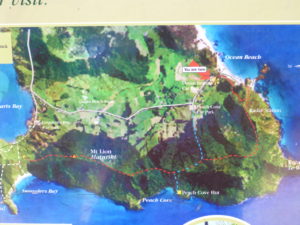
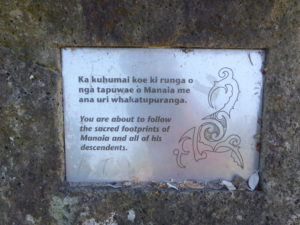

The day had started early, in the cool, when I made a packed lunch. We set off in Tui, Rob in his walking shoes and me in my brand new pair, the replacement for the ones that I had bought in Dunedin. On the right one the sole parted from the upper and the toe fabric just disintegrated, so the company kindly sent me a new pair.
The Mount is named after a sacred chief, Manaia and the five high rocky crags that comprise The Mount represent himself, his wife and three children. The way to Oceans Beach is along his sacred path. The 420 metre high climb is not that bad for the walker as the car park is well up the hillside.
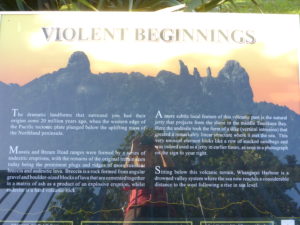
We weren’t the first to start the climb as a number of folk came down past us, “Not far now,” they’d assure us. I was amazed at the number of very young children enthusiastically making the climb until we arrived at the minimal lookout 1200 steps later after just under an hour.
Fine views greeted us across our previous anchorage in Urquarts Bay into the South Pacific and over to Great Barrier and Bream Bay, with Marsden Oil Refinery at the mouth of the river and kept us engrossed for a few minutes.
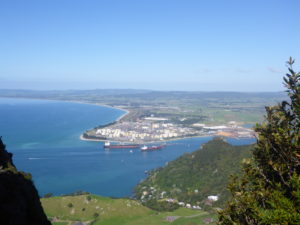
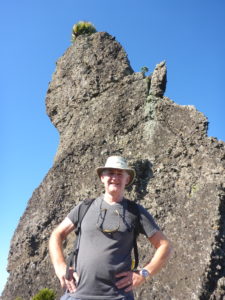
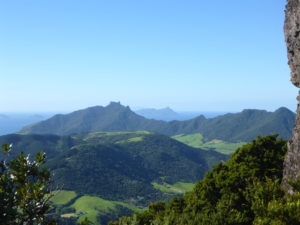



On the way back down the path and boardwalks were scattered with kauri leaves and seeds and we recognised lots of slender seedlings. I hope they will thrive into the future for hundreds of years when maybe we will have learned to live in harmony with nature like indigenous people do.
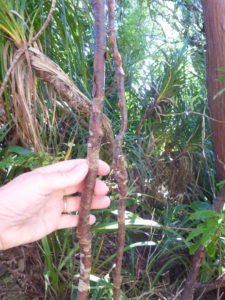
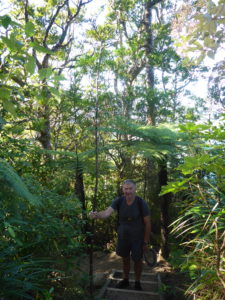
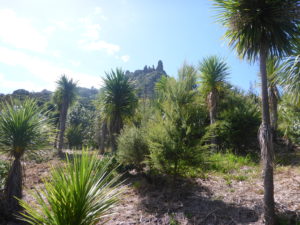
Please bear with me now dear reader as I work backwards over the Easter Weekend. On Sunday we joined Gail and Tony on an Arts Trail working from Whangarei Heads in a logical direction toward the Parua Bay Pub for lunch. Well it seems logical to me. To make the best of time we went to centres where a number of artists were displaying their creations rather than to individual studios.
The standards were high and ideas novel and original and people were buying. More than once we heard artists making satisfied comments about being nearly sold out. But the pricing was sensible and who knows when an artist might become internationally acclaimed and therefore a good investment. I would have liked more Maori art on display though.

Saturday was a chill out day on board after an early climb up the re-surfaced Parihaka path to the lookout and on Good Friday we joined Jeannie and Merv and their friends Shirley and Max for a ride on Julie Anne, an oil fired steam train for the short run to the Portland cement works and back. We passed Shirley and Max’s house where Jeannie and Merv entertained us with breakfast a few weeks ago while S & M were touring the south island.
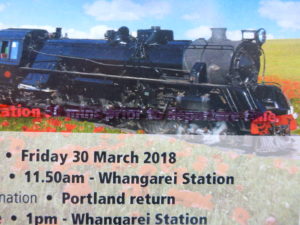
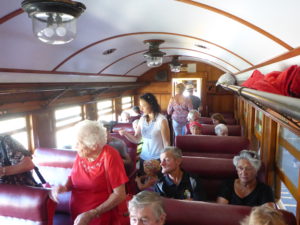
I could not get any decent photos as we were kept behind barricades at the station and the ones I did take were through a grubby loo window as the open area behind our carriage was full with folk, all taller than me.
